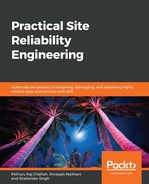One paradigm shift in the IT space in the recent past is the emergence of containers for deftly hosting and running microservices. Because of the lightweight nature of containers, provisioning containers is done at lightning speed. Also, the horizontal scalability of microservices gets performed easily by their hosting environments (containers). Thus, this combination of microservices and containers brings a number of benefits for software development and IT operations. There can be hundreds of containers in a single physical machine.
The celebrated linkage helps to have multiple instances of microservices in a machine. With containers talking to one another across Docker hosts, multiple microservice instances can find one another to compose bigger and better composite services that are business and process-aware. Thus, all the advancements in the containerization space have a direct and indirect impacts on microservices engineering, management, governance, security, orchestration, and science.
The key technology drivers of containerized cloud environments are as follows:
- The faster maturity and stability of containers (application and data).
- New types of containers such as Kata Containers and HyperContainers.
- MSA emerging as the most optimized architectural style for enterprise-scale applications.
- There is a cool convergence between containers and microservices. Containers are the most optimized hosting and execution of runtime for microservices.
- Web/cloud, mobile, wearable and IoT applications, platforms, middleware, UI, operational, analytical, and transactional applications are modernized as cloud-enabled applications, and the greenfield applications are built as cloud-native applications.
- The surging popularity of Kubernetes as the container clustering, orchestration, and management platform solution leads to the realization of containerized clouds.
- The emergence of API gateways simplifies and streamlines the access and usage of microservices collectively.
- The faster maturity and stability of service mesh solutions ensures the resiliency of microservices and the reliability of cloud-hosted applications.
The challenges of containerized cloud environments are as follows:
- Moving from monoliths to microservices is not an easy transition.
- There may be thousands of microservices and their instances (redundancy) in a cloud environment.
- For crafting an application, the data and control flows ought to pass through different and distributed microservices spread across multiple cloud centers.
- The best practice says that there is a one to one mapping between microservice instances and containers. That is, separate containers are being allocated for separate microservice instances.
- Due to the resulting dense environments, the operational and management complexities of containerized clouds are bound to escalate.
- Tracking and tracing service request messages and events among microservices turn out to be a complex affair.
- Troubleshooting and doing root cause analyses in microservices environments become a tough assignment.
- Container life cycle management functionalities have to be automated.
- Client-to-microservice (north-to-south traffic) communication remains a challenge.
- Service-to-service (east-to-west traffic) communication has to be made resilient and robust.
